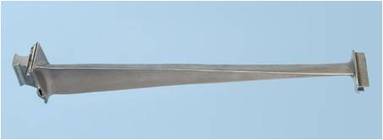Next time you're on a plane, flying off somewhere exotic; spare a thought for the engine. Jet engines have the formidable task of keeping a 300,000 kg aeroplane in the air, at speeds up to 600mph and enduring temperatures hot enough to melt lead...
Environmental focus means that these engines need to achieve these feats at greater and greater efficiencies. To achieve this, the weight of the engine must be reduced, and the performance of the materials under high temperatures must be increased, all without jeopardising the safety of the plane. The European aviation industry has been set the challenge of achieving the following goals by 2050 (the so called ACARE Flight path 2050 regulations - compared against a baseline set for the year 2000):

New technology goals to achieve by 2050*
- 75% reduction in CO2 per passenger kilometre
- 90% reduction in NOx emissions, and
- 65% reduction in noise
(*datum 2000)
The 'specific fuel consumption' (SFC) gives a measure of the rate of fuel use divided by the output thrust, or power, produced by an engine. It is this value that needs to be reduced to meet environmental and fuel burn challenges to remain competitive within the aero engine market. The aerospace industry currently accounts for around 2% of man-made CO2 emissions, however, this is expected to increase as the demand for air travel rises. As a result, materials engineers are challenged with developing new and improved materials to help achieve these design goals.
Where in the engine?
The turbine section, which is situated at the rear of the engine, offers significant options for increasing efficiency. The turbine assembly contains rotating discs and blades, which experience very harsh temperature conditions.
With these components rotating hundreds of times per second and withstanding loads equivalent to that of hanging an averaged size car off each blade, it is clear that the strength of the material to be employed cannot be compromised. Currently a group of metals know as nickel based superalloys are used in service, contributing to the most advanced civil engines to date. Nickel based superalloys are composed of nickel, mixed with solid solution strengthening elements and further strengthened through a form of heat treatment called precipitation hardening.
The low pressure turbine (LPT) region offers the chance to achieve significant weight savings as the aerofoils increase in size towards the final stages of the turbine as the gas flow is exhausted. This section of the engine operates in excess of 700°C; therefore any replacement material must not compromise this performance. Alternative classes of material are under constant review for use within the LPT section.
To operate in this extreme environment, newly developed materials must display the potential for achieving weight loss and maintaining strength at increased temperatures. A class of materials known as intermetallics have long been considered as a potential material for the next generation of gas turbine applications. Intermetallics are a unique class of material; this is due to their atomic structure being what's known as 'ordered'. It is this distinctive ordering of the crystal lattice that generates some of the unique properties seen within intermetallics. An intermetallic known as gamma titanium aluminide (TiAl) has generated interest within the aerospace industry for a considerable length of time.
TiAl's low density offers valuable weight saving which would result in an impressive reduction in overall engine mass as well as the potential for an increase in temperature performance. TiAl has a density of approximately 4.0 g/cm³ which would give a potential weight saving of 50% compared to the current nickel superalloys used in the turbine section. TiAl is particularly interesting as its 'ductility' is considerably improved at these temperatures of around 700°C compared to room temperature performance. Ductility describes a given materials ability to change shape under loading before breaking. Indeed, materials are often classified as being ductile or brittle.
Intermetallics, and in particular TiAl, have found several applications outside of the aerospace industry, the most common being within car engines as valves and supercharger impellers, which are rotating blades improving the efficiency of an engine. Due to the safety critical nature of the aerospace industry extensive testing and research is required before newly developed materials will be selected for service.
New materials - selection for service
For a new material to be considered for use in service, it is critical to understand its mechanical behaviour. Extensive research has been carried out for a number of years on understanding the mechanical properties of TiAl. When considering turbine components, material properties such as 'creep' and 'fatigue' must be fully characterised and understood in order to predict the "safe life" over which a component may be used in service. Creep is a mechanism which causes permanent material deformation under high temperature and static loading. Fatigue refers to the damage caused due to a repeatedly applied, or cyclic loading regime. A typical LPT component may see up to as many as 20,000 hours in flight at temperatures as high as 700°C before overhaul is required.

Methods must be devised to enable engineers to predict the life of TiAl components before they are used within the engine. Lifing methodologies use mechanical test data generated in the laboratory to predict the number of cycles (or flights) a component should survive before failure could occur. Of course from one component to another there will be variations in material microstructure, surface condition and even in-service damage. Therefore these issues must be considered in any prediction models, allowing conservative lifing approaches to ensure all parts within an aero engine operate safely for their entire service life. Understanding of this nature leads to the safe and reliable engines that are seen powering aircraft today.










Comments
Add a comment